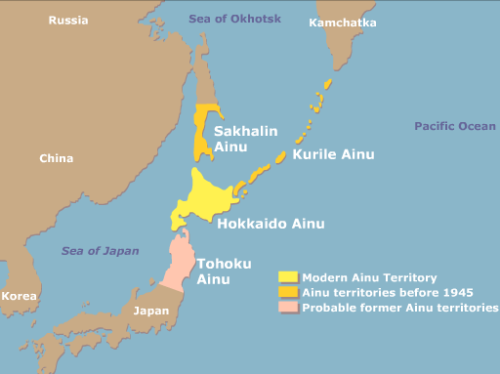"The Ainu are generally considered to be the indigenous population of Japan. But, like all cultures on earth, the history of the Ainu is much more complex than any one label. The 20,000 to 60,000 people who presently identify themselves as Ainu are concentrated on Japan's northern island of Hokkaido, but the Ainu culture once stretched up to the southern part of Sakhalin Island and the Kurile Islands (now part of Russia)."

"When the Japanese state was officially opened to outside influence in 1867, visiting Western scholars became fascinated by the Ainu they met in Hokkaido. They were struck by their "primitive" way of life, their "bizarre" rituals that involved the sacrifice of bear-cubs, the practice of facial tattooing, and their large amounts of body hair. Their facial features, when contrasted with the Japanese on the main island of Honshu, made them look positively Caucasian to these early scholars and explorers." [source]
The woodblock illustrations below were cherry-picked from a Wisconsin University collection of about forty books presenting the earliest depictions - from the 18th and 19th centuries - of the Ainu people by the Japanese. The images are in haphazard order and are primarily of the Sakhalin Ainu (pronounced eye-noo)

'Ezo-shi' by Arai Hakuseki (1720)

'Kita Ezo Zusetsu' vol. 1 by Mamiya Rinzō (1855)

'Ishikari Nisshi' by Matsuura Takeshirō (1860)

'Kita Ezo Zusetsu' vol. 2 by Mamiya Rinzō (1855)

'Ezo-shi' by Arai Hakuseki (1720)

'Kita Ezo Zusetsu' vol. 2 by Mamiya Rinzō (1855)

'Kita Ezo Zusetsu' vol. 1 by Mamiya Rinzō (1855)

'Kita Ezo Zusetsu' vol. 2 by Mamiya Rinzō (1855)

'Ezo-shi' by Arai Hakuseki (1720)

'Kita Ezo Zusetsu' vol. 2 by Mamiya Rinzō (1855)

'Henyō Bunkai Zukō' vol. 1 by Kondo Morishige (1804)

'Kita Ezo Zusetsu' vol. 1 by Mamiya Rinzō (1855)

'Henyō Bunkai Zukō' vol. 3 by Kondo Morishige

'Kita Ezo Zusetsu' vol. 2 by Mamiya Rinzō (1855)

'Henyō Bunkai Zukō' vol. 4 by Kondo Morishige (1804)

'Kita Ezo Zusetsu' vol. 4 by Mamiya Rinzō (1855)

'Kita Ezo Zusetsu' vol. 4 by Mamiya Rinzō (1855)

'Henyō Bunkai Zukō' vol. 4 by Kondo Morishige (1804)

'Ishikari Nisshi' by Matsuura Takeshirō (1860)
[many of these images have been brazenly sliced, diced and modestly doctored for display purposes; click through for enlarged versions; there are a few more in the set]
"All the Ainu engaged in a hunting-gathering way of life. Men hunted and trapped land and sea mammals and other animals, and fished in rivers and sea. Women gathered root crops and other edible and medicinal plants. Although “art” was not a separate sphere of their activity, men were skilled carvers and women were talented in weaving and embroidery. Their oral tradition, both of the Sakhalin and Hokkaido Ainu, was highly developed and some scholars view their lengthy epics comparable to the Greek epics.
For the Sakhalin and Hokkaido Ainu, the bear is their supreme deity. They would catch a bear cub, nurture it and send its soul back to the mountains in an elaborate bear ceremony, which was not only a religious ritual to express their respect for the bear during which they feasted on its meat. It was also a political occasion to display the wealth and power of the political leader and his settlement." [continued]
- 'Ainu Komonjo (18th & 19th century records) -- Ohnuki Collection' is a new offering from the exceptional University of Wisconsin Digital Collections. Click 'Browse' - and once you get through to a specific volume, note the gallery (thumbnail) link in the sidebar.
- Ainu: Spirit of a Northern People feature at the Smithsonian National Museum of Natural History.
- The Boone Collection.
- "Japan's Ainu hope new identity leads to more rights" - CSM [2008]
- "Japan's native Ainu fights for cultural survival" AFP [Nov. 2009]
- Wikipedia / Flickr.
No comments:
Post a Comment